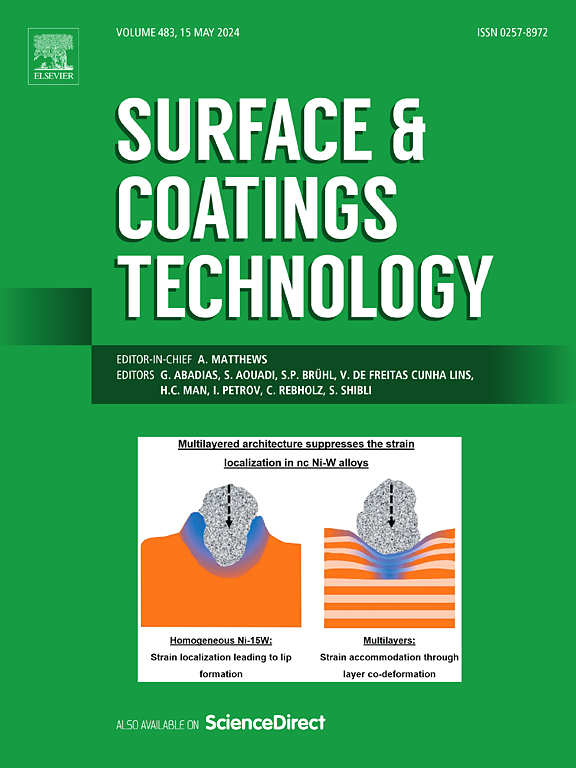Tailoring long-life, wear and corrosion resistant a-C:H coating for marine applications by PVD combined HC-PECVD co-deposition technology
IF 5.3
2区 材料科学
Q1 MATERIALS SCIENCE, COATINGS & FILMS
引用次数: 0
Abstract
Three hydrogenated amorphous carbon (a-C:H) coatings were prepared by physical vapor deposition (PVD), hollow cathode plasma chemical vapor deposition (HC-PECVD) and PVD combined HC-PECVD co-deposition technique. The effects of different deposition techniques on the structural, mechanical, tribological and corrosion properties of the coatings were systematically investigated. The results show that the co-deposited Si/a-C:H:Si:N/a-C:H:Si coating prepared by co-deposition achieved the coverage of surface defects through the deposition of the top layer, and the higher ductility of the top layer also promoted the adhesive properties of the coating. The co-deposited coating exhibited excellent wear and abrasion resistance, with a wear rate of 2.93 × 10−7 mm3/Nm in a 20 h long-life dry friction test, which represented a 40 % reduction compared to the HC-PECVD coating. And the wear rate in the 10 h tribocorrosion test was 9.29 × 10−8 mm3/Nm, showing a 17 % decrease relative to the PVD coating. In terms of corrosion resistance, by virtue of the dense structure of the a-C:H:Si top layer and the thickness advantage of the a-C:H:Si:N sublayer, the corrosion current density of the co-deposited coatings was as low as 2.40 × 10−10 A/cm2, which is an order of magnitude lower than that of the a-C:H coatings prepared by the two single deposition techniques. In summary, the combination of the PVD and HC-PECVD techniques enabled the successful preparation of a-C:H coating with long life, as well as outstanding wear and corrosion resistance.
通过PVD结合HC-PECVD共沉积技术,为船舶应用量身定制长寿命,耐磨,耐腐蚀的a-C:H涂层
采用物理气相沉积(PVD)、空心阴极等离子体化学气相沉积(HC-PECVD)和PVD复合HC-PECVD共沉积技术制备了3种氢化非晶碳(a-C:H)涂层。系统研究了不同沉积工艺对镀层结构、力学、摩擦学和腐蚀性能的影响。结果表明,共沉积制备的Si/a-C:H:Si:N/a-C:H:Si涂层通过顶层的沉积实现了对表面缺陷的覆盖,顶层较高的延展性也促进了涂层的粘结性能。共沉积涂层表现出优异的耐磨性,在20 h的长寿命干摩擦测试中,其磨损率为2.93 × 10−7 mm3/Nm,与HC-PECVD涂层相比,磨损率降低了40%。10 h摩擦腐蚀试验的磨损率为9.29 × 10−8 mm3/Nm,与PVD涂层相比降低了17%。在耐蚀性方面,由于A - c:H:Si顶层的致密结构和A - c:H:Si:N亚层的厚度优势,共沉积涂层的腐蚀电流密度低至2.40 × 10−10 A/cm2,比两种单一沉积技术制备的A - c:H涂层低一个数量级。综上所述,PVD和HC-PECVD技术的结合使a-C:H涂层的制备成功,具有长寿命,优异的耐磨损和耐腐蚀性。
本文章由计算机程序翻译,如有差异,请以英文原文为准。
求助全文
约1分钟内获得全文
求助全文
来源期刊

Surface & Coatings Technology
工程技术-材料科学:膜
CiteScore
10.00
自引率
11.10%
发文量
921
审稿时长
19 days
期刊介绍:
Surface and Coatings Technology is an international archival journal publishing scientific papers on significant developments in surface and interface engineering to modify and improve the surface properties of materials for protection in demanding contact conditions or aggressive environments, or for enhanced functional performance. Contributions range from original scientific articles concerned with fundamental and applied aspects of research or direct applications of metallic, inorganic, organic and composite coatings, to invited reviews of current technology in specific areas. Papers submitted to this journal are expected to be in line with the following aspects in processes, and properties/performance:
A. Processes: Physical and chemical vapour deposition techniques, thermal and plasma spraying, surface modification by directed energy techniques such as ion, electron and laser beams, thermo-chemical treatment, wet chemical and electrochemical processes such as plating, sol-gel coating, anodization, plasma electrolytic oxidation, etc., but excluding painting.
B. Properties/performance: friction performance, wear resistance (e.g., abrasion, erosion, fretting, etc), corrosion and oxidation resistance, thermal protection, diffusion resistance, hydrophilicity/hydrophobicity, and properties relevant to smart materials behaviour and enhanced multifunctional performance for environmental, energy and medical applications, but excluding device aspects.
 求助内容:
求助内容: 应助结果提醒方式:
应助结果提醒方式:


